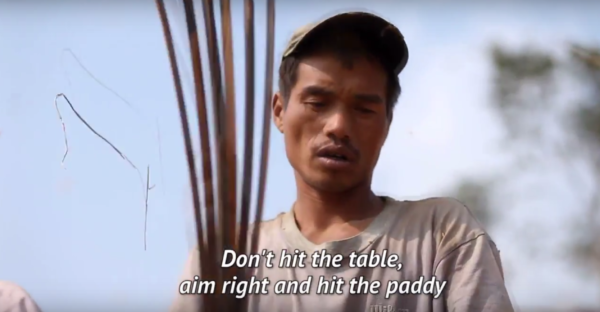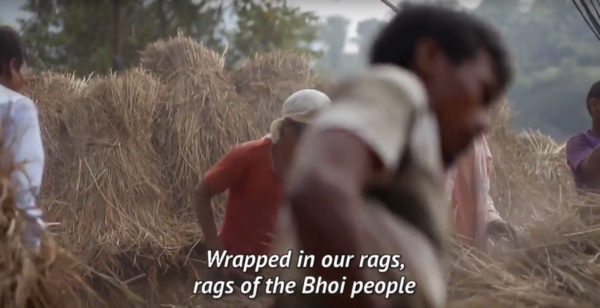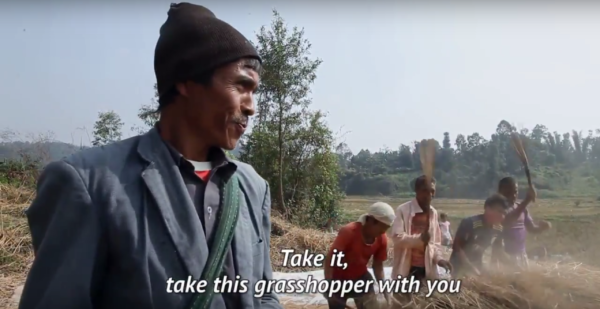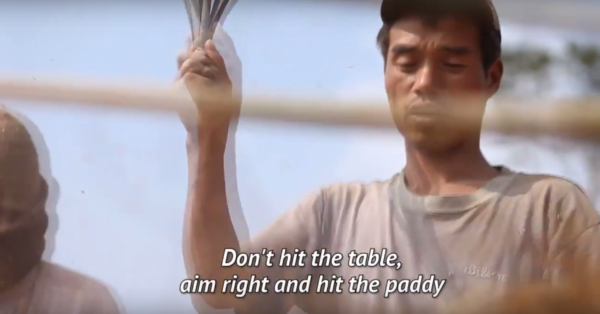Max Arne Kramer
Brief Life of Insects, Escaping Museums – Lak(h)empong Diaries, Sounds from the Truck Country and Kings Have Their Resorts, People Have Their Songs. These four titles of a series of six documentary films make you instantly wonder what may hold them together. Looking for orientation you could read the title of the film-series again – Songs to Live By – and perhaps find a synopsis saying that the films are dealing with indigenous communities in the North East of India. Perhaps you are even more puzzled now by the range of associations from fauna via commerce to state-institutions.
In some ways this series is an exploration of a new form of documentary by Shillong based Hindi poet, filmmaker and editor Tarun Bhartiya. His former filmic engagements include When the Hens Crow (2013) and Darjeeling Himalayan Railway (2010). He won the Indian National Film Award in editing for his work In Camera (2009). The two films he edited for Sanjay Kak Jashn-e-Azadi (2007) and Red Ants Dream (2013) are significant contributions to a cinema of resistance against the state driven violence in Kashmir and in the jungles of Odisha. Both films show a highly contextualized variation between ‚distancing effects’ and more realist representations of political struggle.
With the series on the North-East Bhartiya is exploring new grounds, both formally and in terms of a politics of representation. The titles already suggest that the series produced by the Meghalay Government Department of Arts and Culture is in some ways neither about art nor about culture. At least not in the way most of us would imagine a film to be about a culture or about a form of art. We may more fruitfully engage with this series as an attempt to take a close look at various song-performances and what they tell us about history, memory, power, and social transformation.
The songs seem to be part of a fragile memory that is fading in the rapidly changing societies of the North East. To give one example from the first film of the series „The Brief Life of Insects“. The farmer and musician Albinus Karkongor cannot remember a song he sang threshing paddy just a few months after the filmmaker captured a first performance of the paddy-song and asked him to sing it again for the camera. Even a recording that Bhartiya has done with his mobile phone was of no help to make Albinus remember the lyrics. The song was embedded into a bodily memory of the work on the field which is beautifully captured by the camera and the editing evoking the rhythm of the threshing while portraying the dynamics of the collective work.
In the last film of the cycle „Kings Have Their Resorts, People Have Their Songs“ the song Long Hai was restaged partly for the camera. A woman from Syndai asks: How can we preserve the song if we don’t cultivate millet. A voice from the side of the camera (perhaps the filmmaker) answers: You don’t have to actually cultivate millet. The song or tradition that has faded or is about to fade opens up questions of archive and preservation: who is recording for whom? Since hardly any written source exists in these oral traditions one further question becomes particularly interesting: what is the role of documentary film as an archive of these practices?
All films of the series are formally invested in the multi-sensorial experiences which go into the collective performances of these mostly work-related songs. There is the constant strive for gathering a sensibility not only of the particular – and sometimes lost – ritual context, but also of the films entanglement in the actualities that are produced through the camera. These interventions of the filmmaker are marked through subtle editing strategies that suggest how the presence of the film team re-invoked a ritual context gone by.
While the ritual setting of the Long Hai song was dependent on the harvest of millet, we see a group of women and men discussing how difficult it would be to re-stage this tradition in a time where betel nuts are produced for profit in Syndai. A telephone call from Shillong, the capital of Meghalaya, is signalling the distance of the filmmaker from the everyday context of Syndai and his interest to record something that is no longer practiced. However, some voices in his films make clear that what is gone is an absence that is felt as a lack. The new betel work has suspended a system of voluntary exchange of labour that has been central to the meaning of Long Hai. The films point towards a number of processes of commodification that have transformed the basis of living amongst the communities.
I understand this as the intervention of the filmmaker into a fragile memory. The camera gets entangled in the collective desire to restage something that is lost. But that ‘something’ is not framed within the familiar notion of culture as the way of life of a classifiable group. Instead, Bhartiyas films mobilise a lack from with-out by articulating an aesthetic potential of communality in a sceptical and always curious voice.
The titles of the films are:
- BRIEF LIFE OF INSECTS
22 mins | Ktien Nongtung with English subtitles
- LOVE SONGS OF SOTJAK AND RINGJENG
17 mins | A.chik with English subtitles
- ESCAPING MUSEUMS – LAK(H)EMPONG DIARIES
29 mins | Ktien Nongtung and Sohra Khasi with English subtitles
- SONGS & SECRETS IN SADOLPARA
20 mins | A.chik with English subtitles
- SOUNDS FROM THE TRUCK COUNTRY
39 mins | Pnar with English subtitles
- KINGS HAVE THEIR RESORTS, PEOPLE HAVE THEIR SONGS
40 mins | War Jaintia & Pnar with English subtitles






